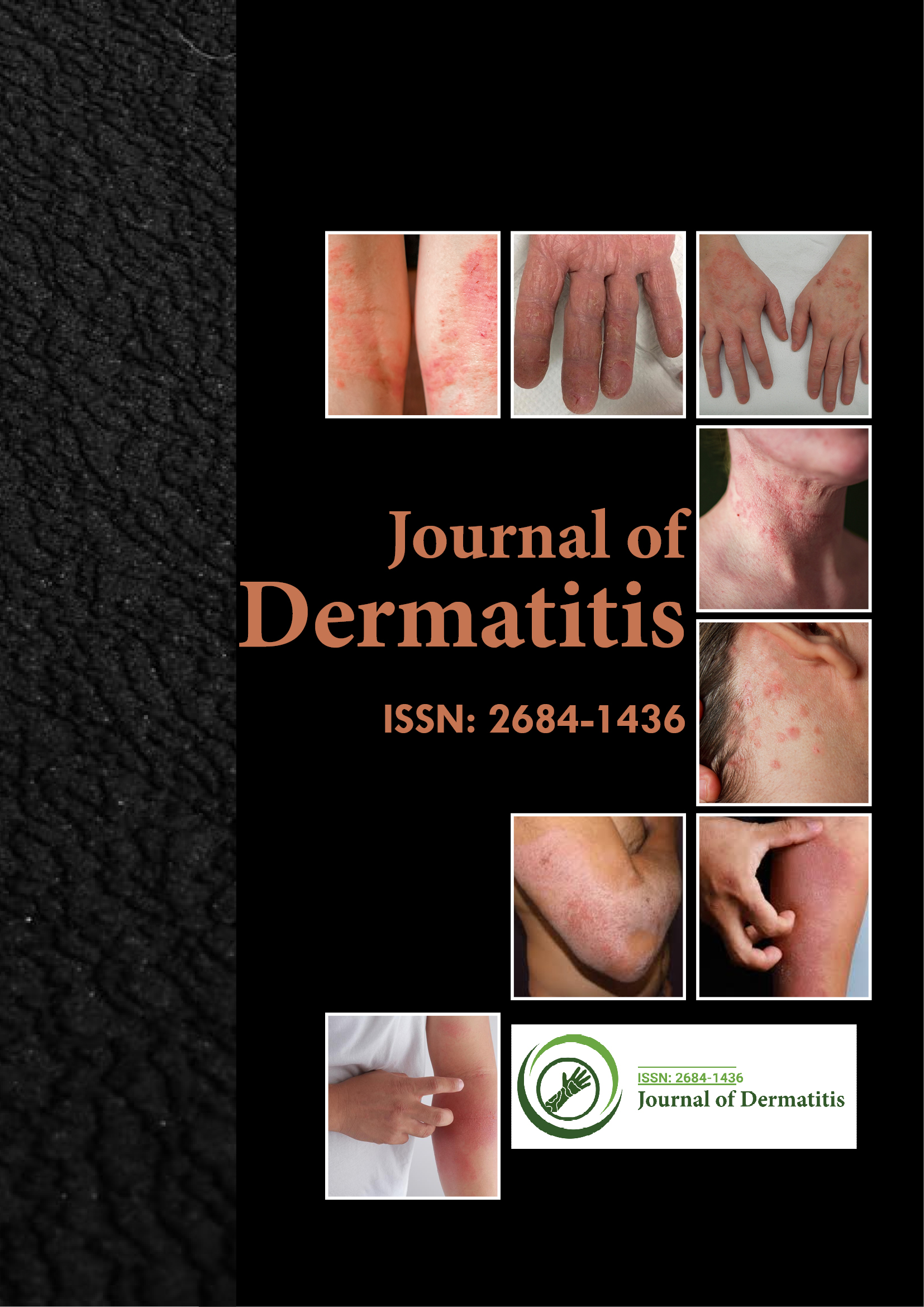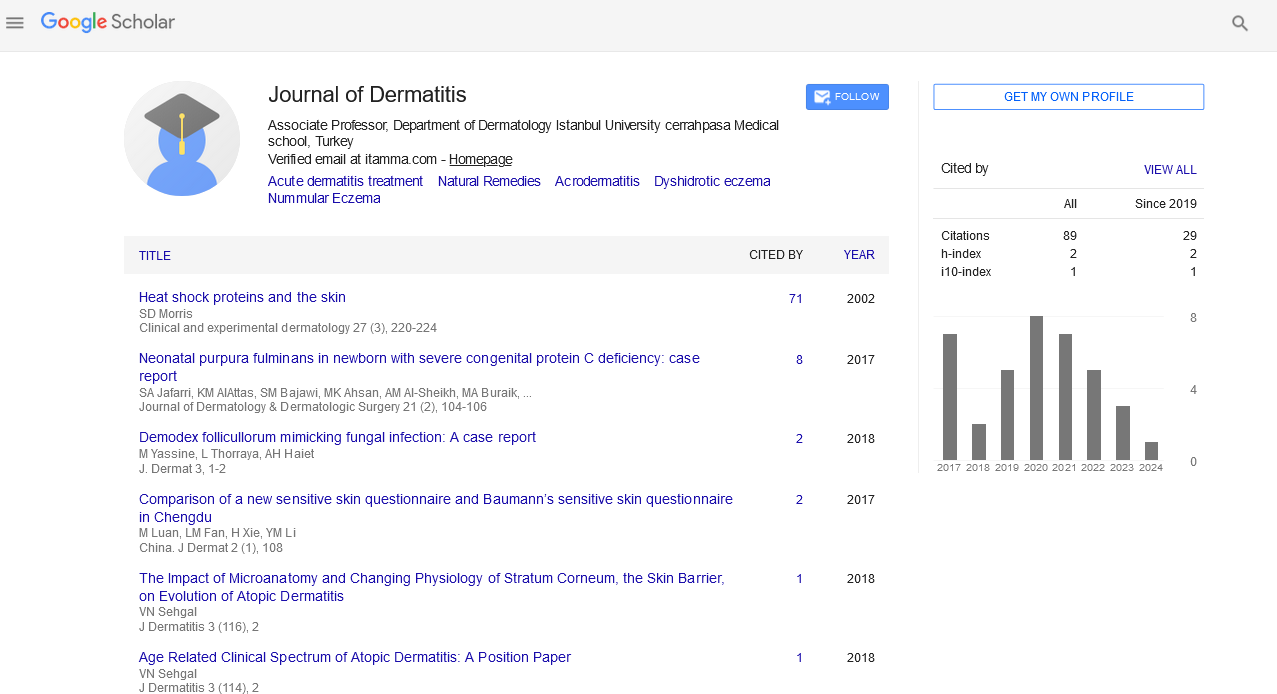Indexed In
- RefSeek
- Hamdard University
- EBSCO A-Z
- Euro Pub
- Google Scholar
Useful Links
Share This Page
Journal Flyer

Open Access Journals
- Agri and Aquaculture
- Biochemistry
- Bioinformatics & Systems Biology
- Business & Management
- Chemistry
- Clinical Sciences
- Engineering
- Food & Nutrition
- General Science
- Genetics & Molecular Biology
- Immunology & Microbiology
- Medical Sciences
- Neuroscience & Psychology
- Nursing & Health Care
- Pharmaceutical Sciences
Opinion Article - (2022) Volume 7, Issue 5
Dermatologic Signs and Symptoms of Toxic Epidermal Necrolysis and Stevens-Johnson Syndrome
Shan Peng*Received: 01-Sep-2022, Manuscript No. JOD-22-18172; Editor assigned: 05-Sep-2022, Pre QC No. JOD-22-18172 (PQ); Reviewed: 19-Sep-2022, QC No. JOD-22-18172; Revised: 26-Sep-2022, Manuscript No. JOD-22-18172 (R); Published: 03-Oct-2022, DOI: 10.35248/2684-1436.22.7.165
Description
A genuine emergency could be caused by the dermatologic symptoms of Stevens-Johnson syndrome or toxic epidermal necrolysis. The degree and extent of skin detachment distinguish Stevens-Johnson syndrome from toxic epidermal necrolysis, which is regarded to be a single disease entity with common causes and mechanisms.
Involvement of more than 30% of the skin surface, full-thickness epidermal necrosis, at least focally, and extensive erythematous macules and targetoid lesions are the hallmarks of toxic epidermal necrolysis, an acute illness. The mucous membranes are frequently affected as well. The fatality rate for toxic epidermal necrolysis can be close to 40%, and nearly all cases are brought on by drugs.
Purpuric macules and targetoid lesions, full-thickness epidermal necrosis, however with less cutaneous surface detachment and mucous membrane involvement are symptoms of Stevens- Johnson syndrome. The same goes with toxic epidermal necrolysis: drugs are significant inciting agents. If a drug is the harmful substance, symptoms may start to appear 4-28 days after exposure. Stevens-Johnson syndrome or toxic epidermolysis syndrome may occasionally result from Mycoplasma infections, while it may also manifest atypically with no skin lesions and just mucosal involvement, which is known as Fuchs syndrome. Compared to toxic epidermal necrolysis, the fatality rate linked with Stevens-Johnson syndrome is substantially lower, at about 5% of patients.
The degree of skin sloughing affects the prognosis for many disorders significantly. The mortality rate substantially worsens as the percentage of skin sloughing rises. However, the disease process abruptly halts in certain people for unknown reasons, and a fast epithelialization process follows. The death rate is substantially higher in patients who have extensive sloughing of their skin. When comparing the mortality rates of adults and children, children have a substantially lower mortality rate than adults.
In order to reduce mortality, early transfer to and care in a burn unit are provided, along with supportive and symptom-focused care. The optimal course of treatment is supportive care coupled with an early withdrawal from the offending substances. The prevention of long-term sequelae, which are important causes of morbidity, is another factor in treatment. The following supportive care facets should be taken into account: psychological support, sedation and pain control, and prevention of infection.
Patient history and physical examination
1-3 days before any cutaneous lesions, constitutional symptoms including fever, anorexia, malaise, myalgias, cough, or sore throat may manifest. Patients may have photophobia, a burning rash that starts symmetrically on the face and upper chest, and a burning feeling in their eyes. In up to 45% of instances, ocular symptoms are the first sign or symptom to appear. It's crucial to outline a drug exposure timeline, especially in the one to three weeks before to the cutaneous eruption.
Primary lesions
Stevens-Johnson syndrome/toxic epidermal necrolysis's early skin lesions are ill-defined, erythematous macules with darker, purpuric cores. The lesions are distinct from the typical target lesions of erythema multiforme in that they only have two colour zones: a central bulla with a surrounding macular erythema or a central purpura. A typical target lesion comprises three distinct colour zones: a macular erythema surrounding a pale, edematous zone and a centre, dark purpura or bulla.
A categorization suggests that less than 10% of the body's surface area is affected by epidermal detachment in Stevens-Johnson syndrome (BSA). When Stevens-Johnson syndrome and toxic epidermal necrolysis coexist, there is a more extensive confluence of erythematous and purpuric macules, which results in 10–30% of the BSA's epidermis being detached. Epidermal detachment in classic toxic epidermal necrolysis is greater than 30%.
Targetoid lesions are absent in a rare type of toxic epidermal necrolysis called toxic epidermal necrolysis without spots, and blisters develop on confluent erythema. It is necessary to have an epidermal detachment of at least 10% to diagnose these situations.
When compared to Stevens-Johnson syndrome, bullous erythema multiforme may have epidermal detachment of less than 10% of the BSA, although typical target lesions or raised atypical targets are generally concentrated in an acral distribution.
Stevens-Johnson syndrome/toxic epidermal necrolysis causes areas of denuded epidermis that are dark red and have an oozing surface. Nearly all patients have mucous membrane involvement, which may show up before skin lesions do during the prodrome.
Complications
Cutaneous
Cutaneous consequences, which can impact 23–100% of patients with Stevens-Johnson syndrome and toxic epidermal necrolysis, are the most frequent aftereffects of both conditions.
A few examples of cutaneous complications are as follows:
• dyspigmentation following an infection (hyperpigmentation or hypopigmentation)
• Irrational scarring
• Rupturing nevi
• Changes in nails (onychomadesis, anonychia, pterygium formation, ridging, dystrophy, abnormal pigmentation)
• Telogen effluvium
• Areata alopecia
• chronic itching
• Hyperhidrosis
• Photosensitivity
• Ossification that is heterotopic
• Ectopic sebaceous glands that are dispersed
In a 2017 article published in the American Journal of Dermatopathology, it was detailed how a young guy who got Stevens-Johnson syndrome had pseudomelanomas. His preexisting nevi were evaluated, and none were found to be abnormal. Three of his nevi had changed clinically a few months after his discharge, and a biopsy of each nevus indicated a pseudomelanoma condition.
Citation: Peng S (2022) Dermatologic Signs and Symptoms of Toxic Epidermal Necrolysis and Stevens-Johnson Syndrome. J Dermatitis.7:165.
Copyright: © 2022 Peng S. This is an open-access article distributed under the terms of the creative commons attribution license which permits unrestricted use, distribution and reproduction in any medium, provided the original author and source are credited.

